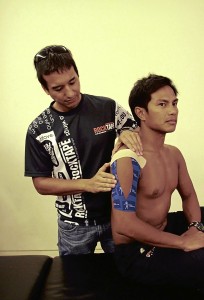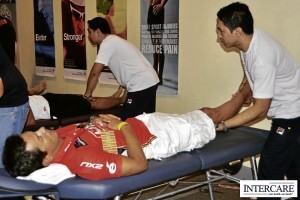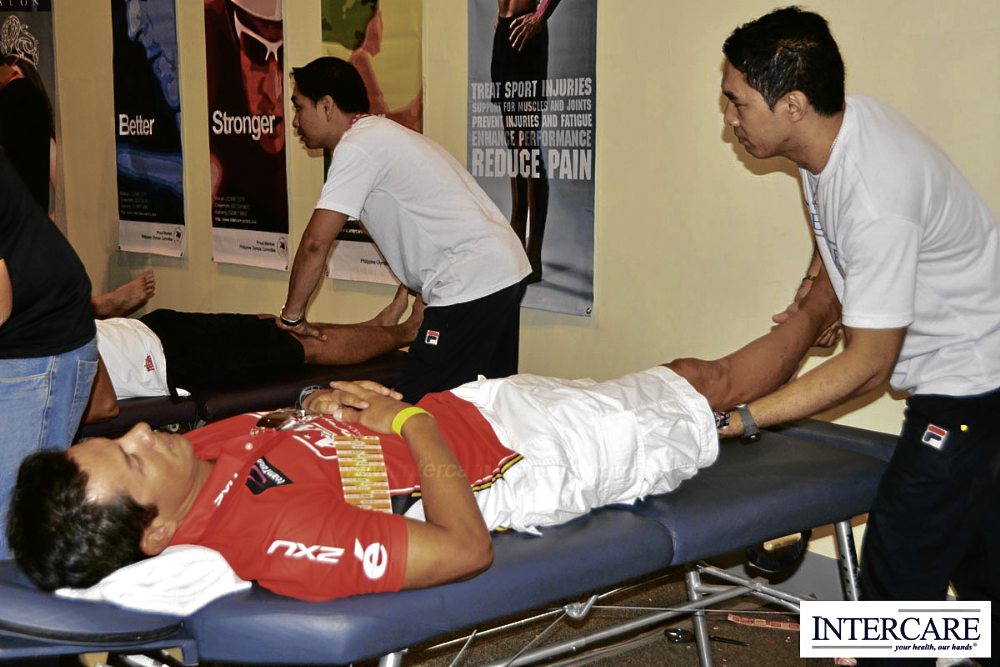
Triathlete-chiropractor Martin Camara is an avid user of athletic tape. When he literally road-tested an Australian brand called Rocktape at the recent Sunrise Events Inaugural Century 51.50 in Subic, he was impressed.
To evaluate the athletic tapes, he applied one brand on his calf and Rocktape on the other leg in the same exact pattern. While training for the run, he observed that the other brand started to peel off after 4 km, while the Rocktape stayed pasted even after five days of intense training in running, biking and swimming.
On the day of the race, which was also Camara’s first Olympic-distance triathlon, he applied the Australian athletic tape to his calves and quadriceps. “It helped support me during the challenging, albeit entertaining race course, providing recovery while I pushed my body through the water, roads and golf course to the finish line. Once off the bike, my calves started to cramp. I honestly feel that if it weren’t for the Rocktape, it would have escalated to the point where I may not have been able to finish the race.”

Camara first learned of Rocktape when his patient, triathlete-executive Wilfred Uytengsu, gave it to him as a pasalubong.
Uytengsu had just competed in IronMan World Championships in Hawaii, one of the world’s most demanding endurance races. The president of Sunrise Events and chief of the Polo Club triathlon team said this tape stayed put on his body for the full IronMan.
Lifting mechanism
Ever since the Beijing 2008 Olympics, colorful athletic tapes have been replacing the zinc-based porous tapes that rigidly strap the joints for support and compression. While these tapes can impede circulation and movement, the new generation of athletic or kinesiology tapes are made of cotton and elastic fibers woven all the way through. Their pliability facilitates movement while supporting the muscles. These tapes are favored by athletes for the immediate benefit of pain reduction and improved range of motion.
Many brands of kinesiology or athletic tapes have emerged for a variety of uses. Available in vivid colors, they are either taped over the injured area or they follow the movement of the connective muscles and tissues. They are tugged in many degrees of tautness, customized to the wearer’s condition.
Applied in a slew of patterns such as stripes, crisscross and fan shapes, the tape provides support, corrects postural problems and increases lymphatic drainage.
Rocktape Inc. markets its tape to consumers as an enhancer of athletic performance. Unlike traditional athletic tape that binds but doesn’t stretch, Rocktape is made of a special cotton weave that mimics the elasticity of human skin. It easily picks up the skin to establish a small space between the muscle and dermis layers. That space relieves the pressure off inflamed muscles and creates space for drainage and blood flow.
“Lactic acid and other metabolites are released faster during the sport—affecting the overall performance of the muscle. This becomes more apparent during longer distances where the muscle’s ability to process lactic acid gets affected by fatigue. The lifting mechanism also mechanically distracts the area and can decompress nerve endings, muscles and the interstitial spaces (fluid compartments). The tape is likened to putting an additional layer of connective tissue. It can connect and correct the pulling of these muscles.
“The tape also enhances sensory input from the skin to the brain. The added input from the tape can enhance propioception, the individual’s sense of position in time and space. This is important for sport and for retraining after an injury. The other element is the improved circulation. Getting blood in and out of an area facilitates more oxygen to the tissues that are working hard to perform the activity.”
Healing faster

Sometimes, the athletic tape is applied from neck to foot.
Camara explained: “Our bodies work as a chain of muscle, bones and ligaments working together to make movement possible. Performance is related to all of these individual elements working together in a finely coordinated manner, orchestrated by our nervous system and our mind. The tape enhances the feedback from the chain so the nervous system can fine-tune the connection and make it work more efficiently.”
Taping can help runners and dancers easily cope with common injuries such as plantar fasciitis (inflammation and pain in the bottom of the foot due to its repetitive pounding on a hard surface) and shin splints (pain on the shin bone).
“For hamstring strains and knee pain, it can help decompress the knees or support the hamstring. It can even provide feedback from the muscles which can alter their running stride, strike or form,” said Camara.
He observed that tennis players and golfers often complain of pain on their lower backs and elbows. “The repetitive, one-sided nature of the sport can put more pressure on one part of their body. Rocktape can help support the areas of the lower back that are stressed by the sport, thereby minimizing more serious back injuries from occurring. The propioceptive input from the tape can also enhance the ‘control’ component of the sport—the athlete’s sense of position in relationship to the club or racket. Tennis elbow or golfers’ elbow is caused by the strain placed on the elbow from flexion and extension. When left untreated, this can even lead to nerve compression syndrome. Rocktape helps support the area, relieving the stress off that elbow.”
Acts like a cradle
At the Rocktape workshop, Australian chiropractor Brent Dellar, who conducted the seminar, explained: “This tape was developed with athletes in mind. It looked at all aspects of the sport—perspiration, water and contact sports. We made sure it’s got extra stretch and can enhance movement. The adhesive doesn’t contain zinc so there are less allergic reactions, and it lets the skin breathe very well.”
In Australia, Dellar uses this athletic tape on shoulder injuries in cricket, baseball, basketball and rowing. He also utilizes it in low back, knee and hamstring injuries in basketball and football. “The tape allows you to play if there’s a mild injury. It can get you through a game most of the time. It allows healing quickly. A five-week injury is reduced to four weeks. For a professional sportsman, it’s important.”
He cited other uses of the tape outside of sports, such as pulling back the jutting chin from being stooped in front of the computer or supporting pregnant women in their full term.
It even helps women recover from a mastectomy as Rocktape substitutes for a decompression bandage.
Dellar has applied it on all ages, from as young as a two-year-old to senior citizens. Stricken with cerebral palsy, the toddler had tape on her left leg to help her walk better. “It’s about retraining the brain and stimulating the proper muscle function through taping,” said Dellar.
Girls reaching puberty tend to hunch their shoulders when they develop breasts. “The taping puts their shoulders back in place, but it’s an additional tool. It will help them know they have a posture issue,” said Dellar.
For elderly patients, the tape puts their knee, shoulders and arms into position after a bad fall.
The tape has been applied around the joints of patients after a knee replacement to stabilize the kneecaps.
He added that when the lower abdomen gets too heavy for pregnant women, a tape is applied under it and acts like a cradle. “It works well for mothers struggling with the heaviness,” he said.
Likewise, it can also be applied around thickened ankles to reduce the swelling.
Although taping is effective when done by trained clinicians, manufacturers offer instructional videos and fliers. Consumers of Rocktape can log on to rocktape.com.ph so they can learn how to apply it.
“In the end, the taping is all about supporting the muscle and taking the pressure off the joints,” said Dellar.
Rocktape is distributed by Intercare. Call tel. 8903378 to 79, 7246631, 8076863.











































